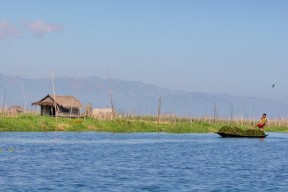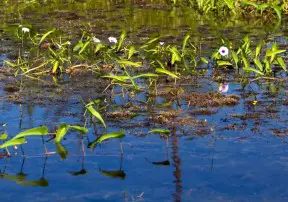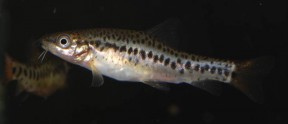Petruichthys brevis
Inle Loach
SynonymsTop ↑
Nemachilus brevis Boulenger 1893; Eonemachilus brevis (Boulenger, 1893); Nemacheilus brevis Boulenger, 1893; Noemacheilus brevis Boulenger, 1893; Yunnanilus brevis (Boulenger, 1893)
Etymology
Petruichthys: probably named in honour of Romanian ichthyologist Petru Mihai Bănărescu (1921-2009), in combination with the Ancient Greek ἰχθύς (ikhthús), meaning ‘fish’.
brevis: from the Latin brevis, meaning ‘short’. Boulenger did not explain why this name was chosen.
Classification
Order: Cypriniformes Family: Nemacheilidae
Distribution
Known only from isolated Lake Inlé and surrounding watershed in Shan state, eastern Myanmar, and the nearby He-Ho plain.
Type locality is ‘Inlé Lake, Fort Stedman, southern Shan States, Myanmar, elevation 3000 feet’.
The species is currently listed as ‘Vulnerable’ on the IUCN Red List due to deterioration of Lake Inlé. Unsustainable agricultural practices in and around the basin have caused increases in sedimentation, eutrophication, and pollution along with a reduction in surface area of more than 30% between the years 1935-2000. Non-native, predatory Parambassis and Tilapia species have been introduced for farming, while collection for the aquarium trade may also be exerting a negative effect.
Habitat
Lake Inlé lies in a karstic valley almost 900m above sea level in the Shan Plateau region and is home to many endemic animals including nine species of fish and numerous gastropods. The water is clear, shallow (2-3 metres deep in most places) and has a very fertile, loamy substrate, although it can be muddy and turbid around the margins.
It is famed for its stilted villages and local fishermen known as Intha who row their boats using only one leg. These people, thought to have migrated from the south of Myanmar in the late 1300s, use naturally-occurring floating ‘islands’ consisting of tangles of various plant species as gardens.
These islands form a wide raft around the lake margins, rising and falling with the water level, and have come to form the habitats of many fishes which take shelter among the tangle of roots and plant stems at their base. Macrophytes also grow densely in places.
Maximum Standard Length
Male 35 – 40 mm; female 55 – 60 mm.
Aquarium SizeTop ↑
Minimum base dimensions of 90 ∗ 30 cm or equivalent are suggested.
Maintenance
Best maintained in a planted aquarium, and an excellent choice for the carefully-aquascaped set-up. The addition of some floating plants, driftwood roots or branches, and leaf litter seems to be appreciated.
If you wish to raise fry alongside the adults the addition of fine-leaved aquatic moss such as a Taxiphylum sp. is advisable (see ‘Reproduction’).
The water should be well-oxygenated but not turbulent, although some flow is acceptable.
Water Conditions
Temperature: 18 – 24 °C
pH: 6.0 – 8.0
Hardness: 54 – 268 ppm
Diet
Likely to be a micropredator feeding chiefly on small insects, worms, crustaceans, and other zooplankton in nature.
In the aquarium it must be offered items of a suitable size and quality, particularly small live foods, although fine-grade or crushed dried foods are also accepted.
Behaviour and CompatibilityTop ↑
Peaceful and likely to be intimidated or outcompeted for food by larger or more boisterous tankmates, although the presence of similarly-sized schooling fishes seems to help reduce its shyness.
Sexual Dimorphism
Sexually mature females tend to be more robust and noticeably larger than males, with a colour pattern comprising irregular dark spots and small blotches, some of which may be fused to form small stripes or bars.
Males possess a number of short, variably-sized vertical bars along the flanks, which in some specimens are joined to form a solid stripe, and also possess a suborbital flap which is absent in females.
Reproduction
This species has been bred in mature, heavily-decorated community aquaria. A relatively coarse substrate with driftwood roots and plenty of live plants appears to represent the most favourable set-up, presumably because such an arrangement allows some eggs to hatch and subsequently some fry to avoid predation.
NotesTop ↑
This species is sometimes traded as ‘Lake Inle red-tailed loach’ and was formerly included in the genus Yunnanilus, a diverse assemblage of which the majority of members are endemic to the Yunnan plateau in Yunnan province, southern China.
A number of them are known only from a single locality or have very restricted ranges, and in some cases have come to colonise habitats or ecological niches not normally associated with nemacheilid loaches.
Several groups of closely-related species existing within Yunnanilus have been noted and Kottelat (2012) moved those that had been formerly included in the Y. nigromaculatus species group into the genus Eonemacheilus Berg, 1938, while those from Myanmar were included in Petruichthys Menon, 1987.
P. brevis can be told apart from congeners and related species by the following combination of characters: short lateral line with up to 12 pored scales; cephalic lateral line system present with 3+3 supratemporal and 9 pre0perculo-mandibular pores; 16-17 branched caudal-fin rays; caudal peduncle 1.06-1.14 times longer then deep; caidalñ peduncle depth 12-14% SL; eye diameter 6.2-7.6% SL; body depth 23-26% SL.
The family Nemacheilidae is widely-distributed across most of Eurasia with the Indian subcontinent, Southeast Asia and China representing particular centres of species diversity.
Thanks to Charles König.
References
- Boulenger, G. A., 1893 - Annals and Magazine of Natural History (Series 6) 12(69): 198-203
List of the fishes collected by Mr. E. W. Oates in the southern Shan States, and presented by him to the British Museum. - Bănărescu, P. M. and T. T. Nalbant, 1995 - Travaux du Muséum d'Histoire Naturelle : 429-495
A generical classification of Nemacheilinae with description of two new genera (Teleostei: Cypriniformes: Cobitidae). - Freyhof, J. and D. V. Serov, 2001 - Ichthyological Exploration of Freshwaters 12(2): 133-191
Nemacheiline loaches from Central Vietnam with descriptions of a new genus and 14 new species (Cypriniformes: Balitoridae). - Kottelat, M., 2012 - Raffles Bulletin of Zoology Supplement 26: 1-199
Conspectus cobitidum: an inventory of the loaches of the world (Teleostei: Cypriniformes: Cobitoidei). - Kottelat, M., 2013 - Raffles Bulletin of Zoology Supplement 27: 1-663
The fishes of the inland waters of southeast Asia: a catalogue and core bibiography of the fishes known to occur in freshwaters, mangroves and estuaries. - Kottelat, M. and X.-L. Chu, 1988 - Environmental Biology of Fishes 23(1-2): 65-93
Revision of Yunnanilus with descriptions of a miniature species flock and six new species from China (Cypriniformes: Homalopteridae).



















